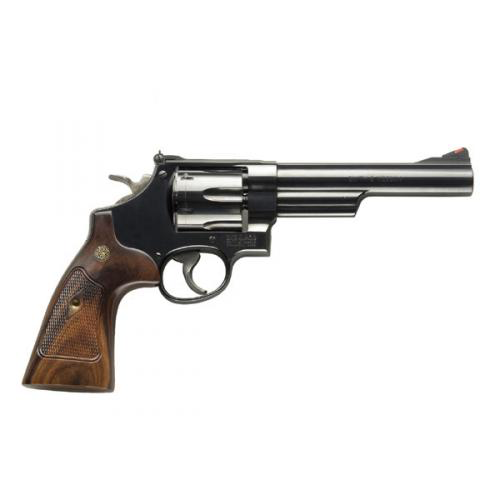Description
sw model 57 – is a large frame, double-action revolver with a six round cylinder, chambered for the .41 Magnum cartridge, and designed and …
In addition to coming with a micro-adjustable rear sight, the Model 57 also had target-type stocks. Except for the bore diameter, it was a dead-ringer for the .44 Magnum Model 29 and could be had in several of the Model 29’s cataloged barrel lengths (4.0, 6.0, and 8.38 inches).
My well-worn 1969 Guns & Ammo Annual lists identical prices for both guns: a cool $165. As befits a sidearm intended for the LE market, the Model 58 could be had for a department-friendly $96 (blued).
However, the Model 58 didn’t catch on for a couple of reasons (see the accompanying sidebar). But the Model 57 did, although primarily with discerning sportsmen (and, yes, collectors) seeking something different.
Even though Keith is reflexively associated with the .44 Magnum, he gave the new .41 Mag. Model 57 a serious big-game test, which he recounts in detail in Hell, I Was There. He took one of the first 4.0-inch specimens with him to Alaska and brought down a pair of caribou (at typically lengthy Keith yardages), and he was thoroughly impressed with the cartridge and the revolver.
One of the earliest “talking points” concerning the .41 Mag. was that it generated less recoil than the mighty .44 Mag. Of course, this proved to be a highly subjective assessment.
While the difference may be noticeable if you’re talking about the old .41 “Police Load” or Winchester’s current 175-grain Silvertip, at a full-house power level many experienced handgunners—including Jeff Cooper—claimed to be unable to see any significant difference between the two. But many .41 Mag. adherents point to the fact that—given similar bullet weights—the .41 will shed less velocity at long yardage than the .44.
Besides the Dirty Harry mystique, the .44 Mag.’s great advantage was that it had beaten the .41 Mag. to market by nearly a decade, and it offered an easy-shooting, easily obtainable .44 Special alternative in much the same way as .357 Magnum users can enjoy a more laid-back .38 Special option.
But the .41 Mag.—much like the 10mm Auto—has managed to gather a dedicated cult following. Enough so that Smith & Wesson has kept the Model 57 in the stable as a member of its highly regarded Classics lineup. If you want a new, blued S&W these days that’ll combine vintage appeal with performance, the company’s “Classics section” is pretty much where you’ll find it.
What’s Old Is New Again
At first I thought the Classics line was part of the company’s Performance Center. Turns out, I was a bit off the mark. S&W’s Matt Spafford set me straight:
“The Smith & Wesson Classics line is a subset of the main Smith & Wesson line…. They do not feature the traditional Performance Center upgrades (action package, tuning, etc.) but are really fully functioning reproductions of the products that were once a part of the standard S&W line.”
Pinned barrels went out in 1982, along with the slightly shorter counter-bored cylinder. The grips on today’s Model 57 Classics are different from the originals in that they are not as beefy as the target-type grips on the original, but the gun does have the true square-butt frame like the original unlike most other current S&W revolvers that share a common K/L/N-Frame round.



Reviews
There are no reviews yet.